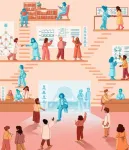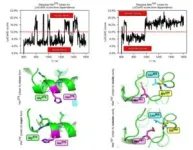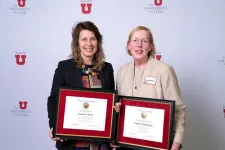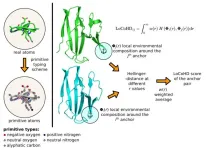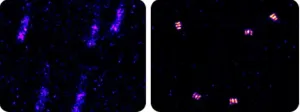(Press-News.org) Moisés A. Bernal, assistant professor in the Department of Biological Sciences at Auburn University, is collaborating with researchers Kathleen Lotterhos (Northeast University), Megan Phifer-Rixey (Drexel University), and Torrance Hanley, (Sacred Heart University) to evaluate the effectiveness of virtual lab meetings in demystifying the hidden curriculum in academia, incentivize primary research among students without previous experience, and foster participation of underrepresented groups in STEM.
The “Biological Practices” article entitled A virtual lab meeting training program mutually benefits mentees and host labs was recently published in Proceedings B, dives into the specific details that are needed to develop a virtual meetings program from scratch, and reports on the experiences by both mentors and mentees. The first step on the NSF funded Virtual Lab Meeting Program (LaMP) was to match research mentors (i.e. faculty in research intensive institutions) with students in STEM fields (i.e. at institutions with limited research support). Bernal indicated
“The program matched mentors and mentees based on affinity of research topics, and mentees were provided with a $500 stipend if they participated in at least 10 meetings,” Bernal said. “This is important because the students had an incentive to participate at the meetings and actively exchange ideas with a research lab.”
The team collected data that shared insight of the value of the LaMP experience.
“When we analyzed the data, we saw a gap that exists between the current mentors and the mentees,” he said. “The mentees were a much more diverse group then the mentors.”
The data included racial and sexual diversity among mentees participating. However, the faculty did not exhibit as much diversity, which highlights the need for this type of program among undergraduate and graduate students.
"Our results clearly show that this program worked to extend the professional networks of traditionally under-represented groups in the sciences, with little extra time commitment on the part of the participating labs,” said Lotterhos. “We hope these results will stimulate similar efforts across STEM disciplines."
And those efforts can be easily integrated into a lab.
“For faculty, this is a small-time investment, because we are already conducting regular lab meetings and we can simply bring on a new mentee into this experience” Bernal added. The results from the study show that the mentees learned new information on specific techniques and study systems, while developing a broader network of personal connections in academia. Further, the mentees learned how to discuss and present research as well as how to discuss a manuscript and the overall writing process. Meanwhile, mentors indicated it was beneficial to gain novel perspectives on how to discuss peer-reviewed manuscripts, and gain knowledge on other study systems presented by the mentees. Overall, the survey results indicate that the program was useful for staff and students in the mentor’s lab as well as the mentees, and participants strongly recommend this program to future participants.
Bernal spoke about his time with a virtual student in his lab.
“It was a positive experience because I was able to have someone in my lab with a novel perspective on how to discuss manuscripts and to look at research problems from a new angle” he explained. “This program helps to develop and expand professional networks for participants. It also helps them prepare to apply to graduate school and learn how to build their CVs over time.”
Overall, the LaMP initiative represents an effective way of connecting researchers with students in STEM, while fostering the participation of underrepresented groups in academia.
END
Virtual lab meetings improve undergraduate research experience and foster diversity in academia
2024-05-30
ELSE PRESS RELEASES FROM THIS DATE:
Study shows effectiveness of updated COVID-19 vaccines wanes moderately over time, is lower against currently circulating variants
2024-05-30
May 29, 2024
Boosters that target the omicron subvariants of SARS-CoV-2 are still providing reasonably durable protection against infection, hospitalization and death from COVID-19, according to new data from a study led by researchers at the UNC Gillings School of Global Public Health.
Published today in the New England Journal of Medicine, the study found that COVID-19 boosters targeting the XBB.1.5 subvariants were most effective one month after receiving one. After four weeks, the vaccines were 52.2% effective at preventing infection and 66.8% effective at preventing hospitalization.
The vaccines were also highly effective ...
Researchers expose new ‘origin’ theories, identify experimental systems for plant life
2024-05-29
STARKVILLE, Miss.—A Mississippi State faculty member’s work on plant life symbiosis—a mutually beneficial relationship between living organisms—is pushing back against the newer theory of “single-origin”—that all life stems from one point—instead suggesting “multiple-origin” theory which opens a better understanding for genetically engineering crops.
Ryan A. Folk, an assistant professor in the MSU Department of Biological Sciences and herbarium curator, is an author on a paper published this month in ...
Researchers honored for outstanding contributions to cancer care
2024-05-29
Three Huntsman Cancer Institute researchers have recently been recognized for their work as outstanding faculty members at the University of Utah (the U).
Kim Kaphingst, ScD, director of cancer communication research at Huntsman Cancer Institute and professor of communication at the U, and June Round, PhD, investigator at Huntsman Cancer Institute and professor of microbiology and immunology at the U, were both granted the 2024 Distinguished Research Award. The faculty prize is given annually to scholars who exemplify exceptional research.
Kaphingst’s group explores cancer communication, particularly how to educate patients and families who ...
A new Hungarian method may aid protein research
2024-05-29
In a paper recently published in Nature Communications, the HUN-REN-ELTE Protein Modeling Research Group (Institute of Chemistry) has laid the foundations for a mathematical method, allowing the computer-assisted comparison of the three-dimensional structures of proteins. The method is unique in that while the alternatives available so far only took into account the position of the atoms, the new technique, called LoCoHD (Local Composition Hellinger Distance), also includes the chemical information of the atoms.
Proteins are molecular machines that carry out processes necessary for cells to function, acting as molecular switches, transcribing information ...
AIM algorithm enhances super-resolution microscope images in real time
2024-05-29
When trying to measure molecular structures with nanometer precision, every bit of noise shows up in the data: someone walking past the microscope, tiny vibrations in the building and even the traffic outside. A new processing technique removes noise from optical microscope data in real time, allowing scientists to track individual molecules over 10 times more precisely than was possible before.
A team of bioengineering researchers at the University of Illinois Urbana-Champaign has introduced an algorithm called adaptive intersection maximization, or AIM, that removes high-frequency ...
Rice researchers uncover surprising role of opioid receptors in gut development
2024-05-29
Researchers at Rice University have revealed a previously unknown function of opioid receptors in the development of the enteric nervous system (ENS), often referred to as the “brain in the gut.” This discovery challenges conventional understanding of opioid receptors, shedding new light on their significance beyond pain management and addiction.
Led by Rosa Uribe, an assistant professor of biosciences at Rice and a Cancer Prevention and Research Institute of Texas (CPRIT) Scholar, the research team identified the genes critical for ENS development by conducting a series of experiments using zebrafish ...
Cleveland Clinic and IBM researchers apply quantum computing methods to protein structure prediction
2024-05-29
CLEVELAND - Researchers from Cleveland Clinic and IBM recently published findings in the Journal of Chemical Theory and Computation that could lay the groundwork for applying quantum computing methods to protein structure prediction. This publication is the first peer-reviewed quantum computing paper from the Cleveland Clinic-IBM Discovery Accelerator partnership.
For decades, researchers have leveraged computational approaches to predict protein structures. A protein folds itself into a structure that determines how it functions and binds to other ...
Blood flow makes waves across the surface of the mouse brain
2024-05-29
WHAT: Researchers have, for the first time, visualized the full network of blood vessels across the cortex of awake mice, finding that blood vessels rhythmically expand and contract leading to “waves” washing across the surface of the brain. These findings, funded by the National Institutes of Health (NIH), improve the understanding of how the brain receives blood, though the function of the waves remains a mystery.
A network of elastic and actively pumping vessels carrying oxygenated blood span the surface of the brain before entering the cortex. There, they feed into a second network of capillaries that supply oxygen deeper into ...
More out-of-state patients seek abortions in Washington state
2024-05-29
More out-of-state women, largely from Texas and Alaska, are traveling to Washington state to obtain an abortion than was the case before the U.S. Supreme Court struck down the constitutional right to abortion, according to research published today in JAMA Network Open.
The study tracked the number of abortions performed at the Cedar River Clinics, a large network of care sites in Washington state, both before and after the 2022 Dobbs decision.
Researchers found a 50% increase in out-of-state patients (from 4% to 6%) and documented an average one-week delay in care for all patients seeking ...
Researchers take step toward development of universal COVID-19 antibodies
2024-05-29
SAN ANTONIO (May 29, 2024) – SARS-CoV-2, the virus that causes COVID-19 disease, continues to evolve and evade current vaccine and therapeutic interventions. A consortium of scientists at Texas Biomedical Research Institute (Texas Biomed), the University of Alabama at Birmingham (UAB) and Columbia University have developed a promising new human monoclonal antibody that appears a step closer to a universal antibody cocktail that works against all strains of SARS-CoV-2.
“This antibody worked against the original SARS-CoV-2 strain, Omicron and SARS-CoV, providing ...
